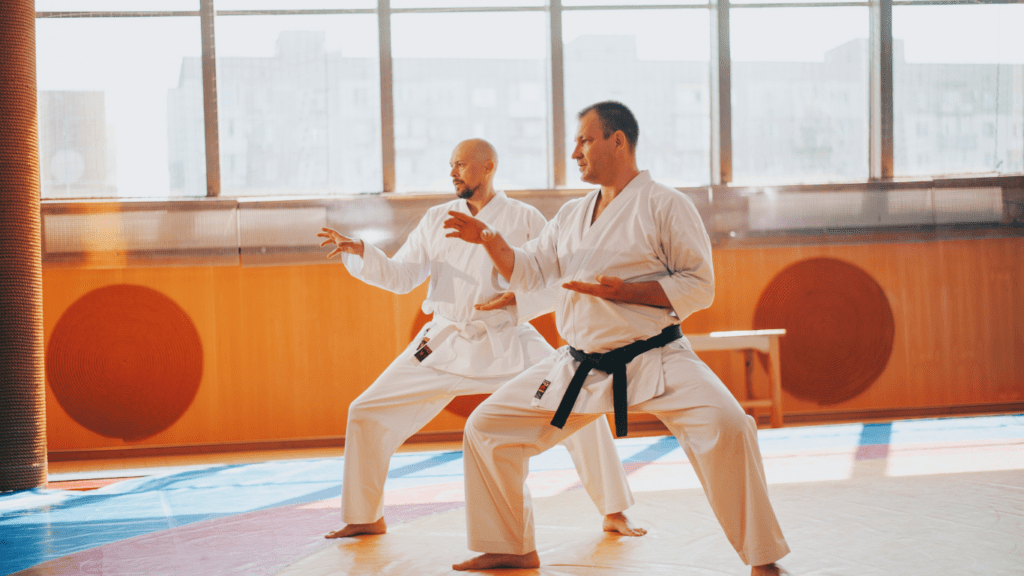The Historical Evolution of Mixed Martial Arts
Mixed Martial Arts (MMA) has a rich history, blending ancient traditions with contemporary practices. Understanding this evolution provides insight into the sport’s dynamic nature.
From Ancient Practices to Modern Battles
Ancient Greek pankration, a blend of boxing and wrestling, shares many similarities with modern MMA. Pankration was part of the early Olympic Games in 648 BC.
The Japanese art of Jujutsu, involving joint locks and throws, influenced many contemporary fighting techniques.
In Brazil, the Gracie family popularized Brazilian Jiu-Jitsu in the 20th century, emphasizing ground fighting. Their challenging “no-holds-barred” fights demonstrated the effectiveness of their style.
The evolution from traditional martial arts to modern battles showcases the adaptability and integration of diverse fighting techniques.
Key Events That Shaped MMA
Several events were pivotal in shaping MMA.
- The first Ultimate Fighting Championship (UFC) event in 1993 aimed to determine the most effective martial art in a real fight.
- Royce Gracie’s victory, using Brazilian Jiu-Jitsu, showcased the importance of ground fighting.
- In 2001, the Fertitta brothers acquired the UFC, implementing rules to improve safety and legitimacy. These adjustments included weight classes, gloves, and rounds, ensuring fighter safety and sport appeal.
- The 2005 launch of “The Ultimate Fighter” reality TV show boosted MMA’s mainstream popularity.
- Fighter Forrest Griffin’s bout with Stephan Bonnar garnered high ratings, demonstrating the sport’s potential for widespread entertainment.
These milestones illustrate MMA’s evolution from ancient practices to its emergence as a regulated, global sport.
Global Influence and Expansion of MMA
Mixed Martial Arts (MMA) has grown from a niche sport to a global phenomenon, impacting cultures and industries worldwide. Its growth presents a modern fusion of tradition and innovation.
The Role of Media in MMA’s Popularity
Media has played a vital role in MMA’s rise. The Ultimate Fighting Championship (UFC), since its inception in 1993, leveraged television and the internet to reach audiences.
They expanded viewership through live broadcasts, pay-per-view events, and social media platforms. “The Ultimate Fighter” reality TV show, launched in 2005, offered an inside look at fighters’ lives, engaging new fans.
Streaming services like ESPN+ and partnerships with global media companies extended MMA’s reach, making events accessible to millions.
Influence on Popular Culture and Fitness
MMA’s integration into popular culture reflects its broad appeal. Celebrities, musicians, and actors endorse MMA, appearing at events and participating in related activities.
Movies like “Warrior” and “Never Back Down” brought MMA to the big screen, contributing to its cultural footprint.
MMA’s dynamic training methods influence fitness routines worldwide, with gyms offering classes in disciplines like Brazilian Jiu-Jitsu and Muay Thai. The sport’s focus on strength, agility, and discipline promotes holistic fitness, attracting diverse participants.
Major Organizations and Fighters

Mixed Martial Arts (MMA) owes its widespread appeal to various key organizations and legendary fighters. These entities and individuals have transformed the sport and elevated its status on the global stage.
Comparing UFC, Bellator, and Other Promotions
The Ultimate Fighting Championship (UFC) stands as the most prominent MMA organization worldwide. Founded in 1993, the UFC has become synonymous with MMA, reaching over 156 countries with 1.1 billion households (source: UFC).
The organization has hosted many of the sport’s historic moments and iconic fights. Fighters like:
- Conor McGregor
- Ronda Rousey
- Anderson Silva
have gained international fame, driving the UFC to the forefront of combat sports.
Bellator MMA, founded in 2008, is another major player in the MMA scene. Known for its tournament format and signing of high-profile fighters like Fedor Emelianenko and Cris Cyborg, Bellator offers competitive events that attract a global audience.
While it doesn’t match UFC’s global influence, Bellator’s strategic partnerships and media deals, including ViacomCBS, amplify its reach and showcase promising talent.
Other notable promotions include ONE Championship and Professional Fighters League (PFL). Based in Asia, ONE Championship focuses on a diverse range of martial arts and has a significant following in the eastern hemisphere.
The PFL, known for its season-format system, culminates in an annual championship with a $1 million prize for each weight class winner. These promotions contribute significantly to MMA’s global footprint.
Prominent Fighters Who Changed the Game
Certain fighters have left an indelible mark on MMA, elevating the sport with their skill, charisma, and groundbreaking achievements.
Royce Gracie, with his pioneering use of Brazilian Jiu-Jitsu in the early UFC tournaments, showcased the importance of ground fighting, revolutionizing MMA techniques.
Conor McGregor’s impact extends beyond his exceptional striking. His crossover boxing match with Floyd Mayweather and magnetic personality brought unprecedented attention and crossover fans to MMA.
Another pivotal figure, Ronda Rousey, demolished barriers for female fighters. Her dominance in the UFC’s women’s bantamweight division and mainstream recognition helped cement women’s MMA as a staple of the sport.
Jon Jones, despite his controversies, displayed unmatched talent and athleticism in the light heavyweight division, setting records and defeating former champions.
Georges St-Pierre, with his well-rounded skills and sportsmanship, earned respect as one of MMA’s greatest fighters, bridging the gap between pre-modern and modern eras of UFC.
These fighters, among others, have pushed the boundaries of what’s possible and set new standards in the sport.
By understanding these organizations and transformative fighters, we grasp the enormity of MMA’s rise and the key figures responsible for its global phenomenon status.
Challenges and Controversies in MMA
Mixed Martial Arts has faced numerous challenges and controversies despite its global rise. These issues range from regulatory matters to ethical questions.
Regulatory Issues and Fighter Safety
Regulatory issues and fighter safety remain paramount concerns in MMA. Unlike traditional sports, MMA’s regulation varies significantly by region.
The absence of standardized rules across different states and countries creates confusion and inconsistency.
In the US, the Unified Rules of Mixed Martial Arts, established by the New Jersey State Athletic Control Board in 2000, provide a framework. However, adoption isn’t universal, leading to discrepancies in officiating and judging.
Countries like Japan and Russia have their own regulatory bodies, with different rules, causing challenges for fighters competing internationally.
Fighter safety is another critical aspect. The high-impact nature of MMA raises concerns about concussions and long-term brain health.
Studies in the Journal of Combat Sports and Martial Arts highlight the increased risk of chronic traumatic encephalopathy (CTE) among fighters.
Organizations like the UFC have introduced improved medical protocols, mandatory suspensions, and stricter pre-fight medical checks.
Ethical Concerns Surrounding the Sport
Ethical concerns are inevitable in a sport as aggressive as MMA. Some critics argue that the sport promotes violence and sets a negative example, especially for young viewers.
The brutal nature of many matches leads to ethical debates about the morality of profiting from fighters’ physical suffering.
Additionally, fighter pay remains a contentious topic. Top-tier fighters earn millions, but lower-tier competitors often struggle financially. This disparity raises questions about the fairness and sustainability of career paths within the sport.
Fighter compensation, as reported by Business Insider, can vary greatly, with many athletes earning less than $50,000 per fight, excluding expenses.
Doping scandals further taint MMA’s reputation. High-profile cases involving banned substances prompt stricter measures from bodies like the United States Anti-Doping Agency (USADA).
Despite their efforts, allegations persist, casting shadows over the sport’s integrity.
Addressing these challenges and controversies is essential for MMA’s continued growth and legitimacy.
The Future of MMA
The future of MMA looks promising with technological advancements and expanding markets playing pivotal roles in its growth.
Technological Advances and Training
Technological innovations in MMA training have revolutionized how fighters prepare. High-tech tools like virtual reality simulations allow for immersive fight scenarios, and wearables track performance metrics in real-time.
Performance analysis through AI aids in refining techniques by providing granular data on movement and efficiency. Training facilities now integrate these technologies, ensuring fighters reach peak physical condition while minimizing injury risk.
These advancements not only enhance training methodologies but also contribute to longer, more sustainable careers for fighters.
Expanding Markets and New Talent
MMA’s expansion into new markets has accelerated its global reach. Promotions are focusing on emerging markets in Asia, Africa, and the Middle East, capitalizing on growing interest in the sport.
The Talent pool is diversifying as athletes from varied backgrounds like wrestling, Muay Thai, and judo bring unique skill sets into the octagon. This influx of new talent ensures fresh matchups and keeps the competition dynamic.
Organizations like the UFC and ONE Championship are establishing academies worldwide to nurture local talent, further solidifying MMA as a global phenomenon.


